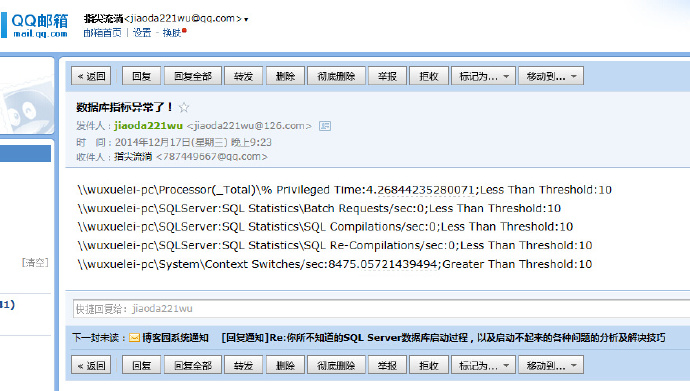需求描述
一般在生产环境中,有时候需要自动的检测指标值状态,如果发生异常,需要提前预警的,比如发邮件告知,本篇就介绍如果通过Power shell实现状态值监控。
监控值范围
根据经验,作为DBA一般需要监控如下系统能行指标。
cpu:
Processor(_Total)% Processor Time
Processor(_Total)% Privileged Time
SQLServer:SQL StatisticsBatch Requests/sec
SQLServer:SQL StatisticsSQL Compilations/sec
SQLServer:SQL StatisticsSQL Re-Compilations/sec
SystemProcessor Queue Length
SystemContext Switches/sec
Memory:
MemoryAvailable Bytes
MemoryPages/sec
MemoryPage Faults/sec
MemoryPages Input/sec
MemoryPages Output/sec
Process(sqlservr)Private Bytes
SQLServer:Buffer ManagerBuffer cache hit ratio
SQLServer:Buffer ManagerPage life expectancy
SQLServer:Buffer ManagerLazy writes/sec
SQLServer:Memory ManagerMemory Grants Pending
SQLServer:Memory ManagerTarget Server Memory (KB)
SQLServer:Memory ManagerTotal Server Memory (KB)
Disk:
PhysicalDisk(_Total)% Disk Time
PhysicalDisk(_Total)Current Disk Queue Length
PhysicalDisk(_Total)Avg. Disk Queue Length
PhysicalDisk(_Total)Disk Transfers/sec
PhysicalDisk(_Total)Disk Bytes/sec
PhysicalDisk(_Total)Avg. Disk sec/Read
PhysicalDisk(_Total)Avg. Disk sec/Write
SQL Server:
SQLServer:Access MethodsFreeSpace Scans/sec
SQLServer:Access MethodsFull Scans/sec
SQLServer:Access MethodsTable Lock Escalations/sec
SQLServer:Access MethodsWorktables Created/sec
SQLServer:General StatisticsProcesses blocked
SQLServer:General StatisticsUser Connections
SQLServer:LatchesTotal Latch Wait Time (ms)
SQLServer:Locks(_Total)Lock Timeouts (timeout > 0)/sec
SQLServer:Locks(_Total)Lock Wait Time (ms)
SQLServer:Locks(_Total)Number of Deadlocks/sec
SQLServer:SQL StatisticsBatch Requests/sec
SQLServer:SQL StatisticsSQL Re-Compilations/sec
上述指标含义,可以参照我上一篇文章:SQL Server需要监控哪些计数器
监控脚本
$server = "(local)"
$uid = "sa"
$db="master"
$pwd="password"
$mailprfname = "SendEmail"
$recipients = ""
$subject = "数据库指标异常了!"
$computernamexml = "f:computername.xml"
$alter_cpuxml = "f:alter_cpu.xml"
function GetServerName($xmlpath)
{
$xml = [xml] (Get-Content $xmlpath)
$return = New-Object Collections.Generic.List[string]
for($i = 0;$i -lt $xml.computernames.ChildNodes.Count;$i++)
{
if ( $xml.computernames.ChildNodes.Count -eq 1)
{
$cp = [string]$xml.computernames.computername
}
else
{
$cp = [string]$xml.computernames.computername[$i]
}
$return.Add($cp.Trim())
}
$return
}
function GetAlterCounter($xmlpath)
{
$xml = [xml] (Get-Content $xmlpath)
$return = New-Object Collections.Generic.List[string]
$list = $xml.counters.Counter
$list
}
function CreateAlter($message)
{
$SqlConnection = New-Object System.Data.SqlClient.SqlConnection
$CnnString ="Server = $server; Database = $db;User Id = $uid; Password = $pwd"
$SqlConnection.ConnectionString = $CnnString
$CC = $SqlConnection.CreateCommand();
if (-not ($SqlConnection.State -like "Open")) { $SqlConnection.Open() }
$cc.CommandText=" EXEC msdb..sp_send_dbmail
@profile_name = '$mailprfname'
,@recipients = '$recipients'
,@body = '$message'
,@subject = '$subject'
"
$cc.ExecuteNonQuery()|out-null
$SqlConnection.Close();
}
$names = GetServerName($computernamexml)
$pfcounters = GetAlterCounter($alter_cpuxml)
foreach($cp in $names)
{
$p = New-Object Collections.Generic.List[string]
$report = ""
foreach ($pfc in $pfcounters)
{
$b = ""
$counter ="\"+$cp+$pfc.get_InnerText().Trim()
$p.Add($counter)
}
$count = Get-Counter $p
for ($i = 0; $i -lt $count.CounterSamples.Count; $i++)
{
$v = $count.CounterSamples.Get($i).CookedValue
$pfc = $pfcounters[$i]
#$pfc.get_InnerText()
$b = ""
$lg = ""
if($pfc.operator -eq "lt")
{
if ($v -ge [double]$pfc.alter)
{$b = "alter"
$lg = "Greater Than"}
}
elseif ($pfc.operator -eq "gt")
{
if( $v -le [double]$pfc.alter)
{$b = "alter"
$lg = "Less Than"}
}
if($b -eq "alter")
{
$path = "\"+$cp+$pfc.get_InnerText()
$item = "{0}:{1};{2} Threshold:{3}" -f $path,$v.ToString(),$lg,$pfc.alter.Trim()
$report += $item + "`n"
}
}
if($report -ne "")
{
#生产警告 参数 计数器,阀值,当前值
CreateAlter $report
}
}
其中涉及到2个配置文件:computernamexml,alter_cpuxml分别如下:
wuxuelei-pc
其中 alter 就是阀值,如第一条,如果 阀值 > 性能计数器值,就会发出警告。
其实这种自定义配置的方式,实现了灵活多变的自动化监控标准:
1、比如可以检测磁盘空间大小
2、检测运行峰值状态
3、定时的根据历史运行值,更改生产系统中的阀值大小,也就是所谓的运行基线
警告实现方式
1、SQL Agent配置Job方式实现
2、计划任务
以上两种配置方式,可以灵活掌握,操作还是蛮简单的,如果不会,可自行google。当然,如果不想干预正常的生产系统,可以添加一个Server专门用来自动化运维检测来用,实现远程监控。
后续文章中会分析关于Power Shell的远程调用,并且能实现事故当前状态下,自动化截图….自动Send Email……为DBA现场取证第一手材料…方便诊断问题…
效果图如下

以上只提供实现方式,如需要内容更新,自己灵活更新。
更多信息请查看IT技术专栏